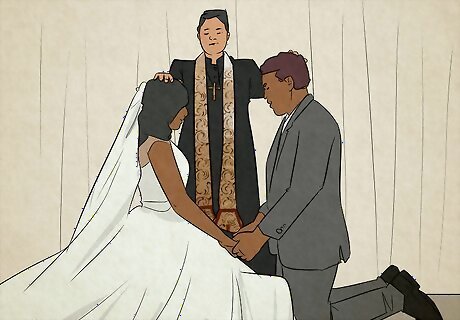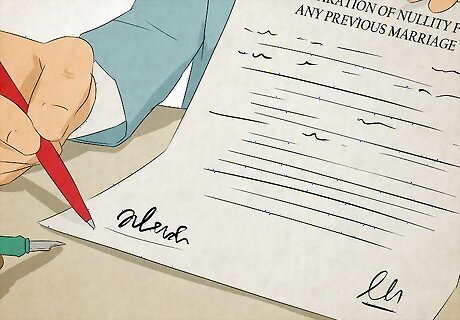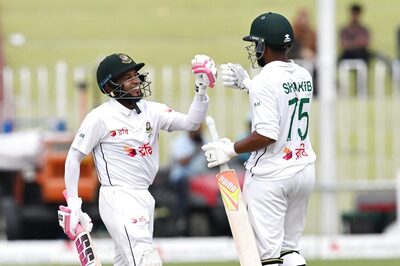
views
- Convalidation is a Catholic ceremony in which a legally-married couple has their marriage formally recognized by the Catholic Church.
- Convalidation allows Catholics and non-Catholics to marry within the Church. It can also affirm the importance of Christ and God in the couple’s relationship.
- Contact your local church to arrange a convalidation ceremony. You may need to submit paperwork and complete martial preparation requirements.
What is convalidation?

Convalidation recognizes a civil marriage in the Catholic Church. A couple that is already legally married through their state can have a convalidation ceremony in their local church. Upon convalidation, the marriage is considered official by the Catholic Church, and the relationship is blessed by God and Jesus Christ. The process is similar to a conventional Catholic wedding. During the ceremony, the couple exchanges vows in front of a priest, bishop, or deacon who conducts the Sacrament of Matrimony—the Catholic prayers that bind a couple together for life in holy matrimony. A convalidation ceremony is equivalent to a wedding ceremony in Catholicism, since you are not “technically” married until you complete the Sacrament of Matrimony. Catholicism doesn’t recognize marriages performed outside the church, including civil marriages (legal marriages under state law) or wedding ceremonies performed by non-Catholic faiths.
Reasons to Have a Convalidation Ceremony

It allows interfaith couples to be married by the Catholic Church. Catholic law permits Catholics and non-Catholics to marry. If you’ve already had a non-Catholic religious ceremony—such as a wedding conducted by a Rabbi or Protestant pastor—you can follow it up with a Convalidation ceremony to have your marriage recognized under Catholic law. Technically, two non-Catholics could also get married by the Church.

It lets religious couples bring their marriage into the Church. In some cases, a devout Catholic couple may get legally married before having a Catholic ceremony. A convalidation ceremony provides a chance to make their commitment “official,” according to their shared faith. For example, a Catholic couple might obtain a civil marriage to secure military benefits, immigration status, parental rights, hospital visitation privileges, and other legal protections available to married couples.

It allows converted Catholics to live by the Church’s teachings. Some folks discover their faith later in life. For Catholics who convert after marriage, a convalidation ceremony can be an important step towards living as a true, practicing Catholic. Catholicism permits converts of any age, background, or previous religious upbringing. If you’re married and your faith is important to you, it’s never too late to have your relationship convalidated.

It can affirm the importance of Christ in your marriage. Catholics consider marriage to be a holy endeavor: a commitment to each other that mirrors the commitment of Christ to his followers. Convalidation places these values at the core of your relationship. A convalidation ceremony can also strengthen the bond you share with your spouse by reminding you that your commitment to each other is an extension of your commitment to Christ.
Planning Your Convalidation Ceremony: Step-by-Step Guide

Contact a local Catholic Church and meet with a pastor. Explain that you and your spouse are legally married and wish to have a convalidation ceremony. Ask to meet with a pastor (a priest, bishop, or deacon) to discuss paperwork and other requirements for arranging the ceremony. Contact your church 4-6 months before your desired ceremony date. If you want to have the ceremony at a specific church, such as in a different city or state, contact that church directly.

Obtain a copy of the Catholic spouse’s baptismal certificate. Contact the church or parish where the spouse was baptized to request a copy. If both spouses are Catholic, obtain both baptismal certificates. If you’re unable to obtain a baptismal record, contact the church where you want to have the convalidation ceremony to explain the situation. They may be able to help you obtain the record, or grant you an exception. If one spouse is not a baptized Catholic, that spouse can choose to get baptized before the convalidation ceremony. But this is not required—and either way, you’ll still need to complete the convalidation ceremony before your marriage is recognized by the Church.

Submit Pre-Nuptial Investigation paperwork to your church. Your church will provide you with this paperwork to fill out. You’ll usually be asked to provide your names, addresses, the dates you were baptized (if applicable), and other general information. You may also be asked questions about your faiths, reasons for getting married, and other personal matters. In most cases, you won’t be able to set a date for your ceremony until the Pre-Nuptial Investigation paperwork is submitted.

Complete marriage preparation requirements with your local church. Depending on your specific church, you may be required to attend workshops, courses, or premarital counseling sessions with a priest. These programs are educational and will help you understand the commitments required in a Catholic marriage. You may be required to attend weekly classes and purchase course materials like a textbook, depending on the church.

Obtain a declaration of nullity for any previous marriage. If one or both of you are divorced, you’ll need to have the former marriage nullified by the Catholic Church before your convalidation ceremony. Contact your church to request a nullification. You may be required to submit paperwork explaining why your previous marriage ended. Some churches only grant a nullification if the marriage failed for a specific reason, such as infidelity, drug abuse, or domestic violence.

Choose a date and time for your convalidation ceremony. If both spouses are Catholic, your church may conduct the ceremony during a Catholic Mass. If one spouse isn’t Catholic, the ceremony might take place after Mass or during unrelated activities. Choose two witnesses to observe the ceremony—one for each party. This is required by Catholic law. You can invite additional guests to your ceremony, but your church may not allow other traditional wedding elements such as a bridal party, groomsmen, and so on.

Attend the ceremony dressed for a Catholic wedding. The bride should wear a traditional white wedding gown with sleeves, or with a shawl to cover bare shoulders. The groom should wear a tuxedo or suit. Guests should dress modestly: avoid exposed shoulders, shorts, or short skirts. The Catholic Church does not recognize gender nonconformity, especially when it comes to dress code. Talk to your church to request an exception if you, your spouse, or any of your guests would prefer to dress differently than the dress for the sex you were assigned at birth.

Celebrate afterward just as you would for a wedding. Throw a reception with food, dancing, and wedding cake, if you like. Plan a honeymoon to a dream destination. Treat your convalidation like a special occasion, because it is. You can skip the celebration if you prefer—or if you already had a wedding reception after your civil ceremony.


















Comments
0 comment